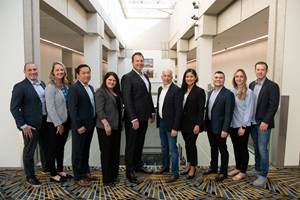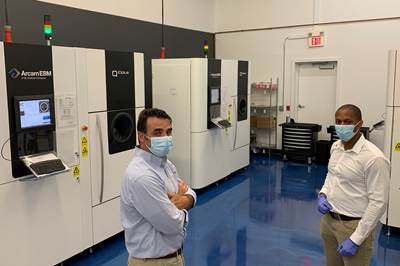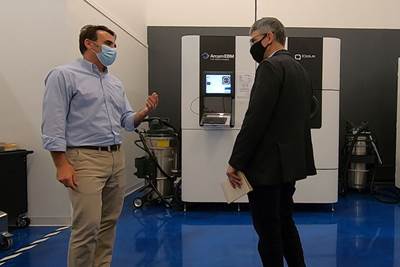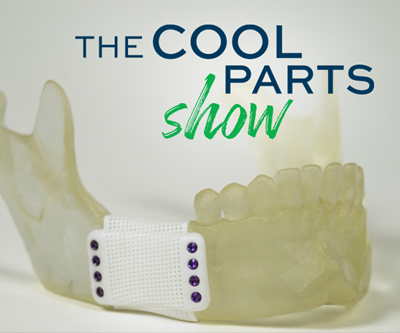3D Printed Scapula Customized for Patient: The Cool Parts Show #25
A patient treated for a tumor of the shoulder blade was able to preserve full use of the arm thanks to an implant tailored to the precise form of the original scapula and made through electron beam melting.
Share
Bespoke surgical implants are among the promises of additive manufacturing (AM). Unique 3D printed implants based on precise 3D measurements of the patient ensure that the implant is a perfect fit, and also enable certain surgeries that might not otherwise be possible. In this episode of The Cool Parts Show, we look at a successful example: a 3D printed scapula replacing that of a patient whose own scapula was afflicted with a tumor.
The new scapula was designed according to data from a CT scan of the original bone. Join us as we hear from the surgeon who embraced 3D printing, Dr. Joseph Benevenia; the implant specialist who designed the scapula, OrthoTiN; and Amplify Additive, the specialist in electron beam melting (EBM) that 3D printed the custom scapula replacement. | This episode of The Cool Parts Show brought to you by Carpenter Additive
The Cool Parts Show is a video series from Additive Manufacturing Media that explores the what, how and why of unusual 3D printed parts. Watch more here.
Have a cool part to share? Email us.
Related resources:
- Ampify Additive and EBM implant manufacturing
- Electron beam melting (GE Additive)
- OrthoTiN
- 3D printed implants
Transcript
Peter Zelinski
How this 3D printed part saved the quality of life, saved the arm, of a patient on this episode of The Cool Parts Show.
Stephanie Hendrixson
The Cool Parts Show is brought to you by Carpenter Additive. The company's Athens Alabama Emerging Technology Center is an end-to-end additive manufacturing production facility with everything from materials development through postprocessing under one roof, ready to help you with your next metal 3D printing job. Check them out at CarpenterAdditive.com. Now, back to the show.
Peter Zelinski
I'm Pete.
Stephanie Hendrixson
I'm Stephanie.
Peter Zelinski
We're with AdditiveManufacturing.media and this is The Cool Parts Show, our show all about amazing parts made with 3D printing.
Stephanie Hendrixson
So Pete, let's jump right into it. What is the cool part that you've brought today?
Peter Zelinski
So we've talked about customization before. The promise of additive manufacturing is to make products that are tailored to the user. We've talked about customized implants before. This is an example of a real success. This is an identical copy of an implant that is in a patient right now.
Stephanie Hendrixson
Wow, that's really cool. We've never had a literal custom implant here in the studio before. So what part of the body is that for?
Peter Zelinski
This is a shoulder blade. This is a scapula.
Stephanie Hendrixson
I don't know that I've ever seen a scapula implant before. Is that because they're not 3D printed, or is this maybe not such a common surgery?
Peter Zelinski
It’s not such a common surgery. Scapula replacement is uncommon, and as a result, there's not really a standard implant solution. Quite arguably it's maybe not even possible for there to be a standard solution because the scapula has to fit in the space defined by the muscle and tissue of the patient. It has to take the exact form of the original bone, and it took a team of people and companies to do this. There was the surgeon who chose that this would be the way to treat the patient in this case. There is the engineering firm that created this custom implant, specialists in custom implants, and then there's the company that did the additive manufacturing, that 3D printed this part.
Stephanie Hendrixson
Okay, so this is an unusual implant. It's unique to the patient, and it took this whole team of people working together. Start at the beginning; you said the surgeon is the one who made the decision to go with this custom implant. What was the diagnosis? What was he trying to accomplish?
Peter Zelinski
The patient had primary malignancy of the scapula, meaning there is a lesion or tumor that had to be removed. That's no trivial thing because your scapula actually does a lot more for you than you might imagine. This is probably the right place to bring in our surgeon. Here is Dr. Joseph Benevenia.
Dr. Joseph Benevenia
The scapula is an interesting bone. It's a flat, thin bone, and its primary function is to serve as the origin or the base of the major muscles around and working the shoulder. As a bone in and of itself, it really doesn't provide any type of direct weight bearing, but it does provide a large surface area for these muscles to originate from. This is what it looks like from the front, and here's the joint again. We call it the glenohumeral joint or the shoulder joint. The area of the scapula that is most critical is this upper area we call the supraspinatus fossa, and this is really the most critical muscle of the rotator cuff. It allows us to elevate our shoulders, to work at shoulder level, or do above-head activities. The nerve for that muscle goes right through this little area called the notch. If that's affected with cancer, then, you know, patients would lose that, and then lose their ability to elevate their arm. In some circumstances, there is no option for the patient with respect to the surgical alternative except for amputation. There are circumstances unfortunately that, you know, unless the patient has an amputation, there is no chance for any type of definitive treatment or cure. In circumstances where there is an option as to a potentially more functional limb versus a less functional limb, a suspension arthroplasty only allows elbow and wrist function. It does not allow you to raise your shoulder, and it does look much different. It's much more of a kind of a hollow withered type of look to the shoulder.
Peter Zelinski
It is possible to do this surgery without a replacement like this, but the result is loss of motion around the shoulder. There is still elbow and hand motion, but in this case the 3D printed implant allowed that shoulder motion, which allowed full quality of life and full range of motion.
Stephanie Hendrixson
I think what I'm understanding clearer now is that this is not a case where there's a standard scapula design you could tweak or adjust for a specific patient. The alternative is not to take an off-the-shelf implant and use that. The alternative is maybe to not replace the scapula at all.
Peter Zelinski
Yeah. I want to focus on something you said. There's no standard design. In a case like this, the design is the patient's bone. The scapula implant has to replicate that so they measure the patient's bone to get the geometry using CT scanning, computed tomography, and they turn to a specialist for that. We talked about the teamwork involved here. The next member of the team, you know, Dr. Benevenia is a special kind of a special surgeon. He's sort of got an engineering bent and he worked with a small engineering firm where the engineers there kind of think like surgeons. The company is OrthoTiN, and they specialize in custom implants.
Stephanie Hendrixson
Okay, so tell me a little bit more about the company OrthoTiN. Ortho makes sense, orthopaedics; where's the TiN come from?
Peter Zelinski
TiN, titanium nitride, which is the name of this gold coating on the outside of this implant. Titanium nitride coating gets you to custom implants and here's how. Your implant is going to be in your body a long time, and you're going to rely on it. You don't want it to wear so the implant needs a really hard surface. Usually or frequently, cobalt chrome is used for implants. It's a very hard metal but it's hard to work with, it's hard to machine. OrthoTiN makes a lot of custom implants through machining, cutting metal. Titanium is easier to work with. This implant was made from titanium, that's what the metal underneath this is. Titanium is easier to work with and adding the titanium nitride coating gets the hard surface that you need.
Stephanie Hendrixson
Okay, so you said that OrthoTiN's specialty is applying this coating to machined implants and I'm looking at this. I don't see any of the open lattice work, or rough surface that we've seen on 3D printed implants. This looks to me like something maybe you could machine. Is that something they considered for this?
Peter Zelinski
Something they considered and something you could machine. So now it's time to bring in kind of one of the people who made that choice: what manufacturing process to use. You'll recognize the last name. I mentioned our surgeon has had a relationship with the company for a long time and so here representing OrthoTiN, his son, an engineer went to work for them. Here is Sam Benevenia.
Sam Benevenia, OrthoTiN
The organic form of the anatomic scapula would require five axis machining, and this sort of complex CNC programming takes time. The fixtures are complex, specialty tools would be needed, and machining times are excessively long because of the size differential between raw material and final part. So additive manufacturing was chosen because it offered a straightforward way to design and fabricate it and allowed us to deliver it in a timely manner. The scapula needed to be replaced, but the bone on the scapula, the glenoid it's called, it's where the articulation between the humerus and the shoulder occurs. So it was healthy enough that the doctor didn't want to sacrifice it. He was able to resect this portion of the anatomical scapula and actually put it inside. That is something you cannot do with a standard device because the standard device is from the joint out. So you replace the surface of the humerus, or you replace the surface of the scapula, the glenoid, and then it goes out from there. You don't have to replace the joint itself if the joint is fine.
Dr. Joseph Benevenia
Preserving this little glenoid preserves this capsule which is around the joint. You can see this area right here that we were looking at before; this tissue around it is the capsule. If you can preserve that little glenoid, you can preserve this capsule, not the muscles, but the soft tissue holding this joint in place. You can avoid all the potential complications that go with an artificial joint replacement, which primarily is dislocation. In saving that glenoid and in turn saving the shoulder joint, it adds a whole other level of complexity and design to the scapula replacement, which was probably the biggest challenge in this situation.
Peter Zelinski
The glenoid was the tricky part. They didn't know if this would work. They went into the surgery and they had options ready to go. They would have done a full shoulder replacement if they had to. They weren't absolutely sure that they got this socket perfect, this interface perfect. They had adapters ready to go in case it didn't fit perfectly, but it did. The CT measurement combined with the additive manufacturing — they replicated that shape perfectly, the shape of the interface, and the surgery went as planned, fortunately.
Stephanie Hendrixson
Okay, so Dr. Benevenia is kind of the starting point making the decision to pursue a custom implant. OrthoTiN designed and coated the implant, but who actually did the 3D printing?
Peter Zelinski
Yeah, so it's time now to bring in the next company that was involved in this teamwork. This is Amplify Additive of Scarborough, Maine, a company specializing in metal additive manufacturing specifically for implants.
Brian McLaughlin
My name is Brian McLaughlin, president and CEO of Amplify Additive. Amplify Additive is a service company focused on leveraging additive manufacturing for the design and manufacturing of orthopedic implants. We are focused on leveraging electron beam melting technology.
Stephanie Hendrixson
Okay, so that actually answers my next question as well, what was the process. Electron beam melting, something we've talked about before. Electron beam melting, EBM, is a powder bed fusion process. It happens at really high temperatures. You preheat the whole bed first, and then you're using an electron beam to melt each layer of powder to build up your part. It's something that's pretty common for metal medical implants like this.
Peter Zelinski
Right and I don't want to oversimplify. It's a sophisticated process, but in this case 3D printing this implant actually wasn't all that difficult. There were no significant design changes necessary to create this form.
Brian McLaughlin, Amplify Additive
The design of this part, from OrthoTiN's perspective, you don't need a whole lot of modification when it comes to leveraging electron beam melting. That’s one of the unique aspects of electron beam melting: There's really no distortion in your components. Because it's done under vacuum at elevated temperatures, there are no localized stresses being created. There's no stress between the platform, which in laser systems the platform tends to be the same material. We don't even need to connect the parts to the platform; we can actually float the part above the platform. When OrthoTiN came to us, we quickly explained to them that we should be able to print this in a matter of days. It worked out that we were able to. When they got us the final design, we were able to put the prints on the platform prepared for a weekend build; therefore the machine was running all weekend while we were hanging out with the family.
Stephanie Hendrixson
Amplify Additive was able to print this implant pretty quickly over the weekend, lights-out essentially. That sort of ties back to what we were talking about earlier with why additive was chosen over machining because of the complexity of that geometry. You would have so many different setups. You would need somebody there at the machine to keep changing the way that the part was oriented, you would need fixturing, and with additive manufacturing you don't have any of that tooling or any of that sort of manual work involved.
Peter Zelinski
That's right. Machining would have introduced a lot of lead time here. Conversely, the digital manufacturing process, the additive manufacturing: This 3D printing build that ran through the weekend like Brian described was able to produce not just one of these implants, but multiple implants within the same build, no extra time. So Amplify made three of them.
Stephanie Hendrixson
Amplify got the design and they had the implants made in a couple of days; what happened next?
Peter Zelinski
Coating also didn't take long. The lead time for all of the part making was actually very short and my understanding is it's so short, it actually proved not to be the bottleneck on this surgery. Actually scheduling time in the operating room was what introduced the delay, and so the parts were actually made days before they were needed. Then the surgery, and the surgery went very well. The patient treated, full quality of life and full range of motion. Here is an x-ray of what that patient's shoulder looks like now.
Stephanie Hendrixson
So this implant tells a pretty powerful story. Not only did this patient recover from cancer, but he got to keep his shoulder blade, keep the movement in his arm and his shoulder, keep his original shoulder joint and preserve the existing quality of life. This is a story about a medical treatment, but it's also a story about somebody's lifestyle and their mental and physical well-being together. I guess the question that this leaves me with as we're coming to the end here is why aren't these kinds of custom implants more common? Why isn't this the go to solution?
Peter Zelinski
I think there's some subtlety to that. Given what 3D printing enables, why aren't custom implants more common? I think we're headed there but it takes more than just the part making process. There's a standard product, a standard implant could be made within a standard manufacturing process, standard facility. But when you get into customization, it requires a change in thinking, a change in workflow, a change in the whole way you think about how manufacturing happens. As we've seen, the surgeon has to be involved in the production process all through it. He's got to have a voice in there, and he has to be guiding it. Let's bring in Dr. Benevenia one more time who will talk about how valuable that relationship is and that teamwork is.
Dr. Joseph Benevenia
OrthoTiN, it happens, is a company where I've known the senior engineer for decades and there's direct knowledge that the engineer has of not only the product, but of the clinical problem that we deal with. Their engineers being on-site in a lot of these cases are able to gain valuable experience in the operating room as to the different nuances of making these implants. That’s always a concern of the surgeon. Does the engineer understand enough from what the surgeon is saying? A lot of times we don't understand the terminology either, and there's always that concern about a communication gap. Fortunately, that's not a factor in this circumstance.
Stephanie Hendrixson
That ties right back into what you were saying near the beginning: a surgeon with the heart of an engineer and some engineers with the hearts of surgeons.
Peter Zelinski
Yeah and we've seen how relatively easy the literal part-making manufacturing part of it is. Maybe this is a picture of the future of what implants will be like, and maybe we will see that surgeons increasingly have that kind of engineering bent as part of their expertise to help patients. The doctor who is able to interface with manufacturing in that way opens up the possibilities that additive manufacturing can bring to implants.
Stephanie Hendrixson
The technology is there and now it's a matter of building those relationships and opening those channels of communication. This is a 3D printed scapula implant. It's custom made for the patient based on the patient's own anatomy. It is 3D printed titanium made with electron beam melting coated with titanium nitride. It represents this really close collaboration between a lot of different parties. Dr. Benevenia, the surgeon, OrthoTiN, the company that designed the implant and then Amplify Additive, the additive manufacturing experts that actually 3D printed it. As a result of their efforts, they created this implant that allowed the patient to not only recover from cancer, but to retain the motion of his arm and shoulder and also preserve the original shoulder joint so that he could have the same quality of life after the surgery as before.
Peter Zelinski
Right, that'll do it. If you have a cool part you'd like to tell us about, something your team of experts is working to make real, we want to hear about it. We might like to do an episode of the show about it. Email us CoolParts@AdditiveManufacturing.media.
Stephanie Hendrixson
If you like the show, we hope you'll subscribe. You can find all of the episodes at the Additive Manufacturing Media YouTube channel or at TheCoolPartsShow.com Thanks for watching.
Stephanie Hendrixson
Thank you to our sponsor Carpenter Additive. Listen to additive manufacturing podcasts, attend webinars and learn more at CarpenterAdditive.com
Related Content
PrinterPrezz/Vertex Manufacturing Rebrands to Zeda
The rebranding is said to reflect the company’s “Z to A” approach, which means it starts first with the customer in mind and ends with a product.
Read MoreGE Additive, Orchid Collaborate on 3D Printing Orthopedic Joint Implants
The agreement bolsters the use of additive manufacturing in the medical implants sector with the development of electron beam melting solutions.
Read MoreDMG MORI: Build Plate “Pucks” Cut Postprocessing Time by 80%
For spinal implants and other small 3D printed parts made through laser powder bed fusion, separate clampable units resting within the build plate provide for easy transfer to a CNC lathe.
Read MoreStratasys, CollPlant Unite Technologies for Industrial-Scale Bioprinting of Tissues, Organs
The joint development and commercialization agreement will initially focus on development of a bioprinting solution for CollPlant’s regenerative breast implants, addressing $2.6 billion market opportunity.
Read MoreRead Next
For EBM Implant Manufacturer, Growth Is Built into the Plan
Amplify Additive needs to be small today. A close, nimble team can innovate quickly and realize the promise of additive manufacturing for orthopedic implants. Yet the company needs to be bigger soon, because success will lead to scalable production.
Read MoreMaterials and Measurement Will Bring the Full Promise of AM — Implants Show This
Complex geometry plus short lead times are only the start of the wins additive manufacturing can achieve. Greater advance will come from material choices and customizing components, as 3D printed implants show.
Read MoreBioceramics for Bone Replacement: The Cool Parts Show #18
A mandibular cage made up of two different bioresorbable ceramics points to the future of bone graft and reconstructive surgeries in this episode of The Cool Parts Show.
Read More











